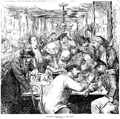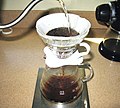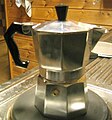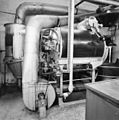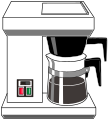The Coffee Portal
Coffee | Drinks | Coffeehouses | Companies | Culture | Preparation | Production
Introduction
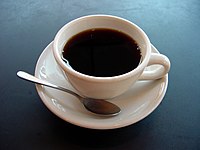
Coffee is a beverage brewed from roasted coffee beans. Darkly colored, bitter, and slightly acidic, coffee has a stimulating effect on humans, primarily due to its caffeine content. It has the highest sales in the world market for hot drinks.
The seeds of the Coffea plant's fruits are separated to produce unroasted green coffee beans. The beans are roasted and then ground into fine particles typically steeped in hot water before being filtered out, producing a cup of coffee. It is usually served hot, although chilled or iced coffee is common. Coffee can be prepared and presented in a variety of ways (e.g., espresso, French press, caffè latte, or already-brewed canned coffee). Sugar, sugar substitutes, milk, and cream are often added to mask the bitter taste or enhance the flavor.
Though coffee is now a global commodity, it has a long history tied closely to food traditions around the Red Sea. The earliest credible evidence of coffee drinking as the modern beverage appears in modern-day Yemen in southern Arabia in the middle of the 15th century in Sufi shrines, where coffee seeds were first roasted and brewed in a manner similar to how it is now prepared for drinking. The coffee beans were procured by the Yemenis from the Ethiopian Highlands via coastal Somali intermediaries, and cultivated in Yemen. By the 16th century, the drink had reached the rest of the Middle East and North Africa, later spreading to Europe. (Full article...)
Selected article -

Coffee is an important agricultural product in the Philippines, and is one of the Philippines' most important export products aside from being in high demand in the country's local consumer market.
The Philippines is one of the few countries that produce the four main viable coffee varieties; Arabica, Liberica (Barako), Excelsa and Robusta. 90 percent of coffee produced in the country is Robusta. There have been efforts to revitalize the coffee industry.
As of 2014, the Philippines produces 25,000 metric tons of coffee and is ranked 110th in terms of output. However local demand for coffee is high with 100,000 metric tons of coffee consumed in the country per year. (Full article...)General images -
More did you know? -
Selected drink -
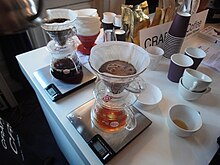
Selected image -
Did you know (auto-generated)

- ... that Franz Liszt's female admirers would fight over his cigar stubs and coffee dregs as souvenirs?
- ... that the Chronicle of the 20th Century was so heavy that it was said to be "the first coffee table book seriously to threaten the well-being of coffee-tables"?
- ... that in a copyright infringement case over a coffee-table history of the Grateful Dead, the Second Circuit held that a reuser can still claim fair use despite negotiating with the rights holder?
- ... that the Highfield Cocoa and Coffee House in Sheffield, England, sold tea, coffee and cocoa at a penny a pint and also provided billiards and reading rooms?
- ... that actor Tatsunari Kimura ate pancakes and drank coffee while talking for eight hours during the filming of the television drama Old-Fashioned Cupcake?
- ... that Justly Watson died suddenly in 1757 from the effects of poison administered in his coffee, it was believed, by a servant?
- ... that Monmouth Coffee Company in Covent Garden was one of the foundations for the third wave of coffee in London?
- ... that the city council of Bandung in the Dutch East Indies initially met at the site of a former coffee-packing factory?
Topics
Categories
Related portals
Related WikiProjects
- WikiProject Agriculture
- WikiProject Beer
- WikiProject Food and Drink
- WikiProject Spirits (semi-active)
- Wikiproject Wine (semi-active)
- WikiProject Bartending (Inactive)
- WikiProject Breakfast (inactive)
- Wikiproject Bacon (inactive)
Associated Wikimedia
The following Wikimedia Foundation sister projects provide more on this subject:
-
 Commons
Commons
Free media repository -
 Wikibooks
Wikibooks
Free textbooks and manuals -
 Wikidata
Wikidata
Free knowledge base -
 Wikinews
Wikinews
Free-content news -
 Wikiquote
Wikiquote
Collection of quotations -
 Wikisource
Wikisource
Free-content library -
 Wikispecies
Wikispecies
Directory of species -
 Wikiversity
Wikiversity
Free learning tools -
 Wiktionary
Wiktionary
Dictionary and thesaurus
Web resources

- World Coffee Research – a 501 (c)(5) nonprofit program of the international coffee industry. (Wikipedia article: World Coffee Research)
- Coffee Research Foundation – based in Kenya, and founded in 1908
- Central Coffee Research Institute – based in Chickmagalur District, India, and founded in 1915




